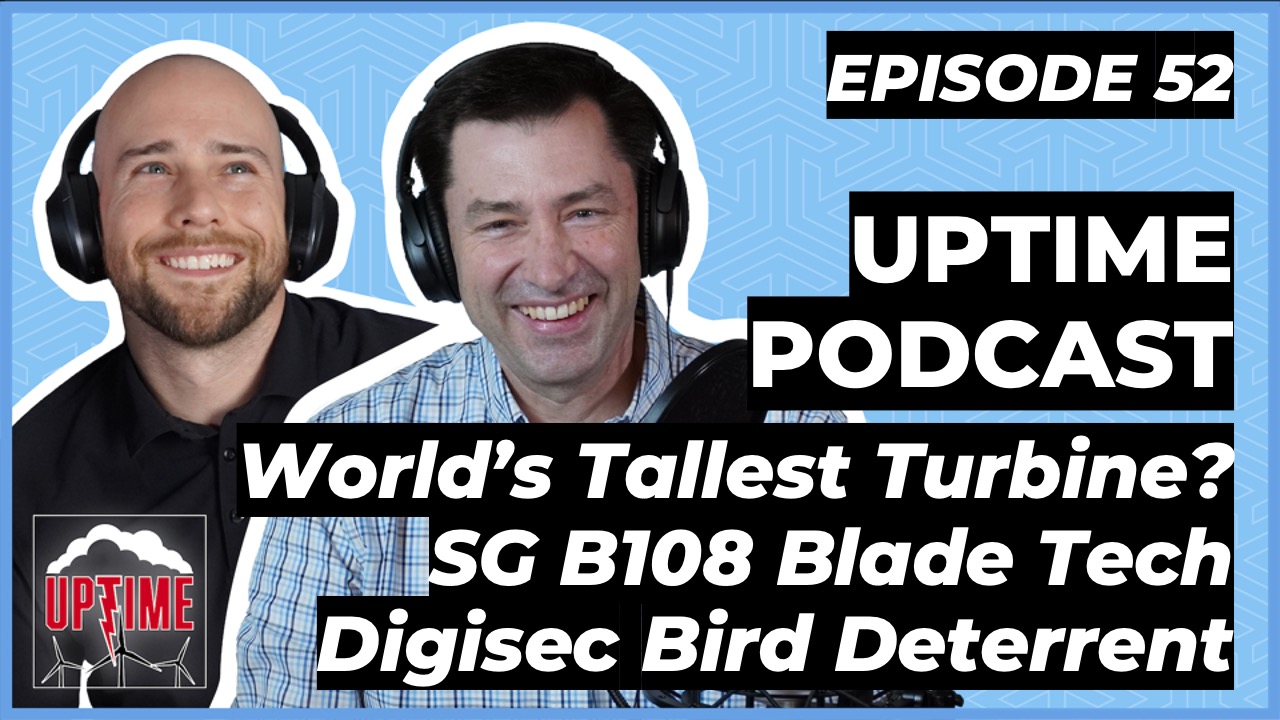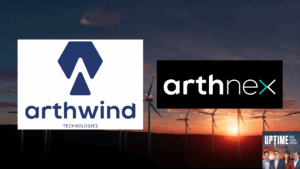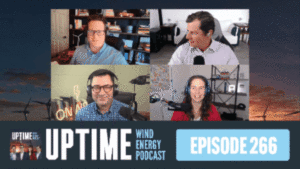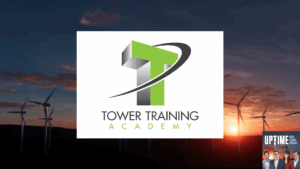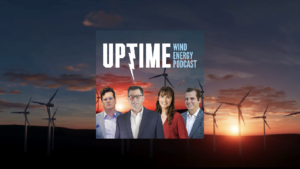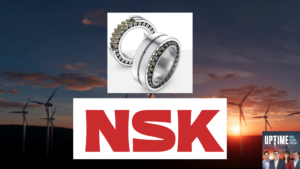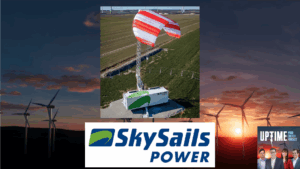Germany built the world’s tallest wind turbine, which features a unique design–a combination of water tower and turbine. We dive into the Siemens Gamesa Renewable Energy B108 blades, which are the largest ever produced, and discuss some of the technology involved in protecting the leading edges and blade tips from lightning. Also on the docket are vertical axis wind turbines being installed on the O2 arena in London, and a review of global wind power commissions from 2020. Watch this episode on YouTube here.
Learn more about Weather Guard Lightning Tech’s StrikeTape Wind Turbine LPS retrofit. Follow the show on YouTube, Twitter, Linkedin and visit Weather Guard on the web. Have a question we can answer on the show? Email us!
Podcast: Play in new window | Download
EP52 Transcript – World’s Tallest Turbine; SG B108 Blades; Digisec Bird Deterrent System & More
this episode is brought to you by weatherguard lightning tech at weatherguard we make wind turbine lightning protection easy if you’re a wind farm operator stop settling for damaged turbine blades and constant downtime get your uptime back with our strike tape lightning protection system learn more in today’s show notes or visit weatherguardwind.com striketape
welcome back i’m alan hall i’m dan blewitt and this is the uptime podcast where we talk about wind energy engineering lightning protection and ways to keep your wind turbines running
all right welcome back to the uptime podcast i’m your co-host Dan Blewett on today’s show we’ve got a bunch of interesting trends from the news world this week number one uh the world’s tallest turbine was built in germany so we’ll talk a little bit about the engineering there um offshore blades are getting bigger we’re going to talk a little bit about the Siemens Gamesa or about Siemens Gamesa’s new 108 meter blade which has a couple interesting features that we want to talk through we’ll talk about global wind turbine commissioning which was actually up by 59 in 2020 which is pretty crazy considering we had a pandemic it was a insane year for everyone in every industry but apparently wind energy did pretty well we’ll also talk about a really interesting bird deterrent system from Digisec some interesting vertical axis wind turbines potentially being installed at the o2 arena in london and a couple other little items so al let’s start with germany and this incredibly tall wind turbine so max bogle wind ag has installed the world’s tallest turbine in stuttgart germany hub height of 178 meters total height of 246.5 meters that’s really tall that’s really tall yeah gosh hey get this out of my backyard like what are you guys doing it’s really tall uh but the technology is sort of a combo between wind energy and and water storage like a water storage battery where the bottom of the wind turbine is actually a water tower so they’re pumping water into this tower and then when they need energy they pump it out and create electricity so it’s like a water storage battery which therefore increase the heights of the turbine so that the germans are they’re ge turbines right they’re ge turbines like three megawatt turbines on top of the this water tower structure which is a very interesting concept because you’re kind of combining two technologies into one and and trying to utilize the best best out of both of them uh it just gotta wonder what the the mechanical stress loading is on something that tall which is being pumped full of water and then drained of water all the time you kind of think that’s a really significant engineering project to accomplish i’m surprised that they could pull it off because this i haven’t seen this anywhere else have you seen this anywhere else it’s common this is the first one but it’s interesting kind of in the same vein as the offshore platforms where they have you know there’s a offshore wind turbine and then they have aquaculture lab like they’ve been talking about all these different ways to combine stuff right it seems like the same kind of thing which is cool right they’re combining water energy storage and obviously a wind turbine so right it’s pretty i think it’s pretty neat that they’re trying to maximize the use and get more out of the same you know same footprint well it’s it will be fascinating to watch as it progresses to see if there if the combination it does pay off in the long term that’s what everybody’s going to watch right they’re going to make sure that if this is a realizable combo then why are another companies picking up and doing it so they need to demonstrate very high efficiency and and reliability with the system if they can do that you think they’d be trying to do this elsewhere so it’s it’s that uh first engineering step where you try to do it on a smaller scale in terms of the number of turbines and then if it works you explode it right you go from ten tournaments to a hundred turns to a thousand terms and ten thousand turbines because that’s that’s the right way to do it and you kind of wonder on the offshore side too if it makes sense on the offshore side to do that because obviously you have access to seawater do you pump it in pump it out as part of a water battery storage system it’s a really interesting concept but we haven’t really seen it anywhere else especially integrated into the turbine base or the hub or not the hub i mean the tower we haven’t really seen that at all yeah yeah well i’ve heard disneyland is going to come out with a 500 meter turbine with a cyclonic roller coaster going up and down you’ll get real close to the blade tips and then no that will never happen but actually that would be pretty cool i mean if it was tall enough you could you know set it at the bottom a little bungee jumping station whatever do all sorts of stuff but i digress um so moving on the siemens games b108 blade which is 108 meters long which will be installed on the um aptly named sg14222d which is their uh 14 megawatt um offshore drive though yeah that we always make fun of because of the name um but this is a really interesting blade a because it’s gigantic but b there’s two big pieces of technology that they highlight on it number one is their power edge technology which is just a you know leading edge solution that they’re installing in-house that they’re developing in-house and they’re explaining it on their website that at a tip speed of 90 meters per second which obviously as these get bigger the tip speeds increase they said this is just gonna destroy leading edges so we’ve got to reinforce these to a significant degree so you know obviously they’re not going into what what this power edge technology entails because obviously everyone’s super secretive in the industry but any any thoughts any speculation on what what they’re doing to reinforce such a such a blade it sounds like a polyurethane solution just reading it about at the top level uh very similar to what happens on aircraft and what other companies are offering right now so polyurethanes are pretty durable material stretchy compliant can take rain impacts multiple rain impacts fairly well not perfectly well depending on speeds they do degrade over time or have shown on the aircraft side to degrade over time you need to replace them once in a while they they tend to one of those one of the failure modes is they tend to yellow or a little bit uv sensitive so that you got to keep an eye on it but i think one of the as you pointed out one of the unique features is that no one’s really talking about what this thing is none of the wind turbine companies actually talk about whether technology is if it’s patentable then clearly they have a patent for it so you know it takes all of two seconds to go on google patents to find out what it is yeah or or to describe it i think that’s one of the disappointing features about this wind turbine industry is that they don’t provide any sort of youtube video analysis data test reports anything on what this what these pieces of the turbines these commercial pieces of the turbine are or how they perform you’re just supposed to read the literature and as we’ve seen time and time again when they’ve if you go back and look especially at uh promotional material for wind turbines they don’t add up to what actually happens in the field so it’s uh you know it’s just it’s just commercial pr work it seems like right now unfortunately it may actually be great but we just don’t know i think that’s the trouble is that you’re in an industry in which it’s gotten beat up so bad about leading edge erosion and yet you have an opportunity to to correct that and i’m not sure we provide the data to show that we’ve done it seems odd yeah well so the other feature that they’re talking about i mean there’s a couple but the one that sticks out is that they have a industry-leading quote-unquote lighting protection system that it sounds like they put a lot of extra engineering into also no real insight into what that might be um but i mean from your perspective what would be some of the things that would have to be included of a blade of this size i mean you know they can’t necessarily have a one piece down conductor right there’s gonna be a lot of different junction blocks probably in between and right i mean if you were designing a lightning system for such a long blade what would be key things that you’d make sure would be in the engineering well a blade of this size will typically have carbon fiber reinforcement as part of the spar or web and they mentioned that yeah yeah so that’s going to drive a lot of the lightning protection design because as we have seen in the past several years there’s been issues where the down conductor starts sparking over to the carbon fiber pieces of the blade and then you have these fatigue failures later on and so just a couple of features you want to be careful about one is that the down conductor inductance isn’t so high that you you do get those flashovers you want to prevent those flashovers and i’ve seen a couple different approaches to that recently but that’s one problem you’d have to solve the other one is just trying to prevent lightning strikes to the carbon fiber that would be bad really bad so they tend to put some sort of metal foil over it to protect it and then just a lightning protection system in general uh how efficient is it and is it efficient while it’s rotating i think that’s the right now it seems to be the biggest issue is while stationary lightning protection systems work great when they’re moving at speed at 90 meters per second not so good so what has been done at speed to demonstrate that the the lightning protection system is working to my knowledge zero i mean there’s been there’s been discussions about it there’s been some masters thesis papers published about it in the last couple of years but in terms of publicized data from the wind turbine companies almost zero about it and i think that’s a real pinch point in terms of the technology and lightning protection systems that you can only test in a lab while it’s stationary and you really can’t test it while it’s moving but the blades are moving at really high speeds and like we have seen on airplanes you get a different there’s different physics involved when they are when the blade or the aircraft is moving at speed you just it’s just not the same thing well do you want to talk about that so obviously the the concept of aircraft lightning zones you know where it could strike in one and as the plane’s hurtling through space at 500 miles per hour it’s going to reattach in a different lightning zone and then maybe even another lightning zone before it finally leaves you know the plane um how does that relate to wind turbine blades well on an aircraft if you think about an aircraft wing how similar it is to a wind turbine blade they’re very similar in terms of shape it’s performance what it does how they’re designed they’re very similar structures the difference between the two mainly between the wind turbine and aircraft is pretty much all the pieces on our aircraft are conductive at some level either made out of carbon fiber or they’re made out of aluminum so everything’s conductive on a wing what you see on an aircraft wing it’s just moving is that the lightning strike is following behind it trying to a lightning attachment to a wing lightning is trying to reattach to the wing the whole time and try to hang onto that wing as long as it can everything on the wing is conductive so it can sort of move inboard and outboard on the wing a little bit on a wind turbine blade it’s a little bit different because most of the blade is non-conductive it’s made out of fiberglass or balsa and plastic resins and very little of is conductive maybe the carbon fiber spar cap is and maybe the down conductor or the two things that are conductive so the where lightning wants to stay attached to is really dependent upon the aerodynamics and what the the most attractive part of the blade is at that particular microsecond yeah and it changes as the blade moves because the blade is moving typically away from the lightning strike just like an airplane is on an airplane lightning can find something else conductive just attached to on a blade it sometimes can’t and so because it has so much massive potential the lightning strike can bore through a blade no problem to find something conductive to attach to which is what it does so the movement of the blade is critical here so is it true that you know it could strike a really high point on the tip that’s mostly fiberglass that’s not really that conductive but then as the blade moves maybe it exposes a portion farther down the blade where there’s a carbon fiber spar and be like hey this is a better spot for me to strike i’m excited now you know lightning but exactly no i think he nailed it exactly so as the blade typically what i think is happening is is that the initial lightning strike or the start of a lightning event to a winter blade is when the blade is kind of mostly vertical uh and it’s it is probably attaching where you want it to for the most part but then it moves away right the blade kind of moves away from where the lightning strike is the lightning strike is actually chasing the blade around the arc of the blade and where it decides to attach is really dependent on a lot of unique physics to lightning lightning doesn’t is not necessarily continuous it’s sort of it pulses it’s just like this pulsy effect so there are times when it’s quiet when i say quiet and there’s not a lot of current flowing in and there are times where there’s a lot of current flowing in it so if if the lightning decides to go quiet for a brief amount of time and the light and the blade moves away from it and then the lightning gets energetic again it wants to dump a bunch of current off somewhere it has to create a new path to the blade and if it can’t find a very easy path it’s going to find the difficult path and take it and go right through the right the blade structure which is what’s happening so that movement combined with sort of the pulsy impulse of lightning strikes is creating a lot of damage on blades and until the industry figures out that it’s not a stagnant stationary problem then it’s a aerodynamic airflow lightning protection issue you got to combine aerodynamics and lightning protection together to make a solution then we’re going to continue having have enough problems we’re just we just are so let’s move on let’s go to um siemens gameza here so interesting article about the offshore bidding rights and the prices for developing some of these offshore sites so andreas nauen who is the chief executive at siemens gamesa you know explained in a recent article that these prices for development are going up which is going to in turn squeeze wind turbine manufacturers to reduce their costs to provide turbines at at cheaper rates so that these projects can make sense um alan i mean what do you see i mean is it just the fact that there’s hey we know there’s more of these being developed so the rates of these offshore land leases if you call it land obviously it’s like you know seabed what’s driving the prices up i think covet is driving the prices up because there’s a lot of investment cash is sitting on the sidelines there’s no with no home and and i i’ll relate it to the tesla stock price rise to a lot of stock price rises to a lot of investment uh billions of dollars investment in some um sectors that wouldn’t otherwise have that kind of money in it right now i think code really shut down the economies but there’s a lot of investor money still in play and they need a place to deposit it and so you’re looking for opportunities long-term opportunities and maybe high growth and one of those opportunities is offshore wind and the the first step in offshore wind is to get the lease to put the wind turbines out there so it creates a sort of bidding issue i think between um investment groups that see a potential in wind and you’re right dan i think there’s a problem with that if you overpay for the lease itself can you manage the the downside risk of you the turbine is going to be expensive you’re going to have maintenance issues all the things that come with wind turbines can you manage that and have a profitable investment return long term who knows right but who get who gets clobbered in these situations all the time it’s the manufacturer they just do right because if you’ve poured a bunch of money into the investment into the property where do you try to recoup some of that you try to try keeping keeping the cost of the turbines down which means you’re going to be super aggressive on uh driving down turbine prices which you know it’s good in one sense that you have an opportunity to make a bunch of tournaments and it’s bad in the other sense is that your profit margins on the turbines may go to almost zero yeah out of the factory kind of reminds me of being you know the term house poor someone over pays for their house and they can’t afford to have lease you know they can’t afford the furniture right yeah they’re just sleeping on the floor et cetera obviously that’s a little extreme example but kind of reminds me of that and another thing that comes to mind is you know this idea just like in texas where maybe and again it’s clear that not all these wind turbines in texas needed winterization right it probably didn’t make economic sense for for some of them um maybe it did for others but when you start to look at all the things that you should maybe insure against by having maybe blade heating or maybe you know this uh extra leading edge protection or vortex generators all these other things you can add um to protect your investment from losing aep over time or whatever right you’re probably gonna start to skimp on them if you’re a developer and you overpaid for your offshore seabed lease right sure man we got to cut the costs ah let’s let’s not do the leading edge thing uh let’s not do the bird determine deterrent thing yeah let’s not do let’s not do the another great examples like fire traces um you know let’s let’s we probably won’t need a fire suppression system let’s cut all those stuff then we can make the numbers work yeah and that ends up being a recipe for a disaster too it does so yeah it’d be interesting to see how this all kind of gets negotiated out if if the the leases are really expensive to the point where it starts to make people nervous and want to start cutting corners because that’s not a good thing long term either right right it hurts the industry long term is what it does
so going forward uh global wind turbine commissioning was up by 59 this past year in 2020 which i think is astonishing for everyone considering how rough of a of a pandemic year we had uh 96.3 gigawatts of wind turbine power installed versus 60.7 gigawatts the previous year and china commissioned 57.8 gigawatts of that so that seems like a big chunk of it obviously um with china sort of soliciting um from all turbine makers um china’s buying from pretty much all of them now so and no noteworthy for go usa um you know general electric company and goldwyn of course we shouldn’t say go usa because you know europe is powering so much of the green energy revolution and our friends over in denmark i mean go denmark you guys are great right like they’ve they’ve got all this all that’s going we’re just catching up trying to do what america does um but ge and goldwyn were the top two turbine suppliers in 2020 on seeding vestis which was uh number one in the past four years so alan what strikes you about this this report does surprise you being that it was crazy cove at times it does but i think one of the industries that has been sort of coveted proof has been wind turbines is in that uh projects yeah well i think the construction projects have have been continuing to on go on go even though uh there have been coveted restrictions depends what part of the country we’re talking about also right a lot of wind turbines down in texas texas has had fewer restrictions and so it makes sense that some of the places will have fewer restrictions on covid are probably also developing wind turbines that seems to be how it works right now so you kind of get gung-ho because your cost of labor may be relatively inexpensive the cost of fuel is way way down right now so you want to if all these things are fuel intensive so you want to do it now because it’s less expensive overall so because your costs are more controlled and things are lower lower quote-unquote prices you may be incentivized to to push ahead and try to get as many projects as you can down while things are cheap which appears to be the case right uh and i i think that’s a sort of a good omen you know that i think the when you look at uh potential growth in the world in terms of wind turbines america is one of those places because of the huge amount of coastlines and also the huge amount of open space that you can put a lot of wind trimmers up instead of putting up in groups of 10 like it usually happens in europe you’re putting up in groups of 100 in the united states same thing in china they tend to be large groups of wind turbines so the quantity of sales are higher by roughly a factor of 10. right so each site in america is roughly 10 times the size of what it is in in europe and if ge is trying to protect their home market which would be america and goldwind and china are trying to protect their homework a little bit that’s why those two are growing faster than the others is because they’re playing on their own home turf that’s that’s what tends to happen so it is it is fascinating it’s grown so much in covet times but i do think if you’re smart you take advantage of the situation this is what happens yeah no that makes sense i mean they’re like you said there’s been a lot of industries that have done very well in covid and of course no one no one’s happy that they thrived in covet i don’t think peloton is you know hey you know love capitalizing on you know people at home awful world events but you know peloton is another example of a company that did very well so yeah anyway um so moving on so the o2 arena which is a extremely busy arena in london is installing vertical wind turbines made by alpha 311 which we’ve actually mentioned them in the past and i we actually i don’t think made the connection before um reading the article uh earlier this week but they’re the ones doing uh the vertical wind turbines that we mentioned on uh embankments or medians for highways so trying to harness some of that wind power that’s created by a car you know driving by at 65 miles per hour so they’re going to be installing initially 10 of these wind turbines on the o2 i don’t know if it’s on the roof exactly but they’re going to be helping to offset some of their electric costs at the o2 arena and perhaps install more of them in the future and aeg who owns the arena is looking to install these at different venues around the world so just another interesting development of course these are vertical wind turbines which we know have been sort of embattled in the past at different scales these are pretty small so they’re four kilograms um but again i mean maybe this is the right application it sounds like these are very sensitive so it only takes a very like almost like a breeze to get them going um so yeah maybe this could work that’d be exciting to see you know places like this offset some of their cost and you know fill in just like with uh eocycle and distributed wind it doesn’t all have to be 15 gigawatts to you know be useful right well i think i think that’s right dan it’s doing things new technology on a small scale and testing it out is really critical to advancing the technology to the next stage which is wider acceptance of it and publicizing the data how well did it do obviously if it does well no two arena that’s a huge publicity coup for alpha three one one in a sense of it’s visible it’s right pretty much in london and it’s you know it pokes that green energy button for a lot of people and if it does work there and does reduce uh greenhouse emissions from the arena great maybe do it in other places because there are plenty of uh what we call soccer stadiums or football stadiums over over in in europe they could do some very similar things and uh it just seems like a pretty good little growth marketplace for them so more power to them let’s let’s see how it plays out i i that’s what i really like is that you know you introduce a product you try it small scale you show that it works you tweak it and where it needs to be tweaked and then you can get to the to the next step and grow it when you have a huge massive output of at one time something that’s not really tested it just typically leads to disaster long term very few projects actually succeed in that pathway even though it’s financially there’s incentives to do it like that the the the better long-term path and the in the longer term growth path is to do what alpha 3-1-1 is doing impressive so last on the docket today uh digisec is a company based in greece and they have an interesting bird monitoring system which pretty like i like their website they’ve done a good good job i think explaining what they’re doing so number one they’re using ai to help detect birds in high risk zones they’re doing this through both thermal imaging and high def cameras and then when this ar ai algorithm which is scanning their you know the imaging that’s coming in when it detects okay those little creatures are birds then it can say all right it looks like they’re coming towards us we need to do something so it sends out an acoustic you know a noise very directional it says to reduce sound pollution to deter the birds from coming in and if it doesn’t then it can also stop the turbine whether it’s temporarily or whatever to reduce any potential impacts so alan how do you feel about this it’s pretty cool cool it’s a really cool technology dan it’s like if you’re going to dream up a bird detection system wouldn’t this be the one you would take a pencil to and say yeah this is what how it would work i would detect for a bird i would try to shoo away the bird by some sort of noise directed at the bird and if i couldn’t make the bird go away i would slow the turbine down and maybe even stop it just so i don’t hit the bird or get the bird too close to the terms and do damage to the bird it seems like it’s the intuitive system i i know i’ve seen a lot of different like the bat deterrent system which seems to work on sonar effects but this is a really fascinating relatively simple design concept and there’s i’m sure there’s a bunch of software behind it but in terms of its hardware implementation it’s it’s not real it’s not really complicated but it is it would be like you would design on a piece of a fresh piece of paper how would you design that system i would design it like this so yeah i see the birds then i yell at the birds and then the birds go away hopefully and if they don’t then i just go in my house that’s that’s essentially yeah yeah it’s exactly what it is so it seems so obvious sometimes the best solutions are the most obvious ones and it seems like they’ve gone to the obvious solution implementation and costs are going to be the drivers right how well how expensive is the system can to keep the cost down to implement it 10 000 or 100 000 times but it again i think they’re trying a small scale which is the best way to start get the data show that it works and then start selling the heck out of it because there are a lot of places on this planet where you need a bird detection system and deterrent system and if if the system is reliable enough then man that seems like it’s a home run yeah and they said it’s not just for wind turbines it could be for airports public spaces wherever um but yeah i think the question is like again for a win site saying hey we have x amount of budget why do we need this like do we have a bird problem when do we have a bird problem is it three bird deaths a year is it 30 you know is it 30 bird deaths a year is it 3 000 like when do they decide they need a bird determine deterrent system and what is that worth to them because it’s not going to make them any money it’s just going to get whether it’s you know environmental um i don’t know if activists is the right word but you know people who like the lorax they speak for the trees they speak for the birds those who are speaking for the birds um you know like hey windsight you’re having a bird problem you know can we work together to fix this um yeah that that to me seems like the bigger hurdle like why does someone say yeah we definitely need a bird system i don’t know and and as some of the research papers that we’ve shared on this podcast have said it doesn’t seem like there’s a massive problem from birds at least in some areas right that one paper that we talked about show the birds were actually pretty good at at detecting wind turbines and flying around them like there was a massive massive study about birds what was it in somewhere overseas in europe but i don’t know so i guess that’s my question is what when sites have bird problems are they aware of their problems and who decides that this is the threshold at which you probably need to start reducing bird deaths because it can’t be zero right um right you know there’s always going to be some amount probably but what’s an acceptable rate i don’t know those those are all i think the hypothetical philosophical questions well throat throw it back to you this way if you could reduce bird impacts to turbines by 90 percent say it went from 100 to 10 in a year that seems like a pretty good number to me that it’s something that’s doable now if it went from a thousand to a hundred there’s another ninety percent decrease again you know that seems like a pretty reasonable number of um bird impact reductions that regulatory bodies will see that as something that should be implemented right and and regulatory bodies don’t always make the most engineering sense at all or financial sense at all it just gets imposed because they feel like it and i get it right it’s hard to quantify the loss of a robin running into a turbine but somebody does i mean someone will put a number on it and demand that it be met how do you deal with that situation and part of the way to deal with the situation is to be up front and try to just to minimize the impact straight up as an industry so you don’t run into that regulatory body you know if you’ve shown good faith effort to minimize problem areas like bird impacts by having a system that does it that’s relatively inexpensive and simple to operate slam dunk i think that’s a slam dunk for the wind turbine industry it’s going to happen going to happen well if you’re out there listening and you you offer operate a wind turbine site you have experience with this kind of stuff let us know shoot us an email um what is the what’s the bird monitoring landscape look like is this something that people are emailing your site about is this something that comes up regularly is this you know
so but all right that’s it we’re gonna wrap this episode of uptime thank you so much for listening be sure to subscribe to the show wherever you’re listening on itunes spotify stitcher uh youtube wherever it is and be sure to share the show with a friend and we will see you here next week on the uptime podcast is downtime causing you financial pain and putting a stop to your power production for months on end it’s no secret lightning strike damage is a major cause of wind turbine downtime this damage is preventable with our easy to install strike tape lightning protection system for wind turbine blades our incredible engineering build quality materials and edge sealants withstand up to five times more abuse in the toughest weather and lightning conditions and we’ve got the research to prove it if you’re tired of constant downtime we can help reach out to us at weatherguardwind.com and schedule a free call we’ll get your uptime back in no time



